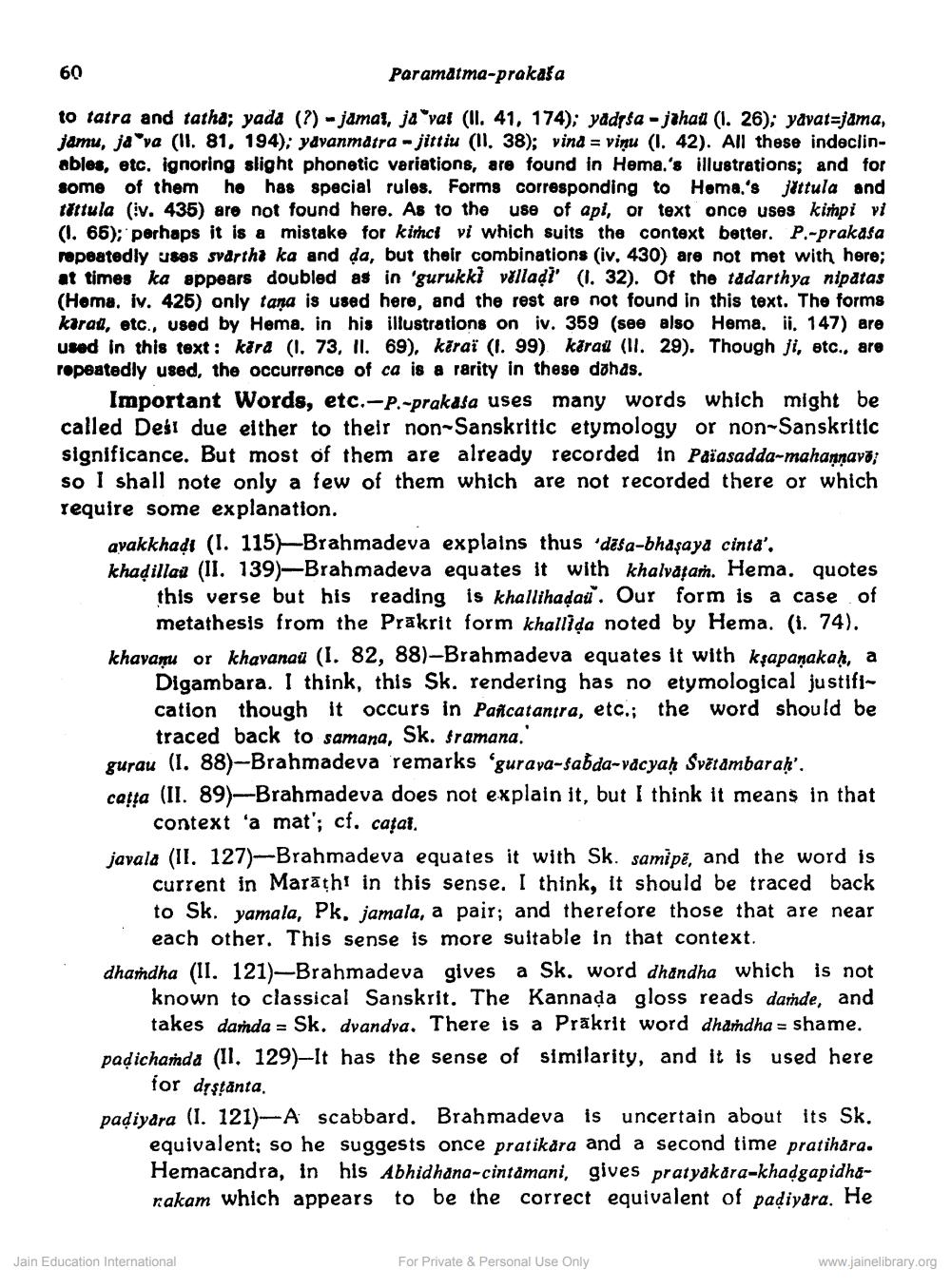________________
60
Paramatma-prakala
to tatra and tatha; yada (?)-jamat, javat (II. 41, 174); yadṛta-jahal (1. 26); yavat=jama, jamu, ja va (II. 81, 194); yavanmatra - jitthu (11. 38); vina vigu (1. 42). All these indeclinables, etc. ignoring slight phonetic variations, are found in Hema.'s illustrations; and for some of them he has special rules. Forms corresponding to Hema,'s jattula and tettula (iv. 435) are not found here. As to the use of api, or text once uses kimpi vi (1.66); perhaps it is a mistake for kihel vi which suits the context better. P.-prakasa repeatedly uses svartha ka and da, but their combinations (iv, 430) are not met with here; at times ka appears doubled as in 'gurukki villad (1. 32). Of the tadarthya nipätas (Hema. iv. 425) only fana is used here, and the rest are not found in this text. The forms kara, etc., used by Hema, in his illustrations on iv. 359 (see also Hema. ii. 147) are used in this text: kira (1. 73, 11. 69), kirai (1. 99) kirad (11. 29). Though Ji, etc., are repeatedly used, the occurrence of ca is a rarity in these dahas.
Important Words, etc.-P.-prakala uses many words which might be called Dest due either to their non-Sanskritic etymology or non-Sanskritic significance. But most of them are already recorded in Païasadda-mahannavõ; so I shall note only a few of them which are not recorded there or which require some explanation.
avakkhadt (I. 115)-Brahmadeva explains thus 'data-bhasaya cinta". khadillas (II. 139)-Brahmadeva equates it with khalvatam. Hema. quotes this verse but his reading is khallihadas. Our form is a case of metathesis from the Prakrit form khallida noted by Hema. (i. 74). khavanu or khavana (I. 82, 88)-Brahmadeva equates it with kṣapaṇakaḥ, a Digambara. I think, this Sk. rendering has no etymological justification though it occurs in Pañcatantra, etc.; the word should be traced back to samana, Sk. tramana."
gurau (1. 88)-Brahmadeva remarks 'gurava-sabda-vacyaḥ Světambarak. catta (II. 89)-Brahmadeva does not explain it, but I think it means in that context 'a mat'; cf. cafat.
javala (II. 127)-Brahmadeva equates it with Sk. samipe, and the word is current in Marath in this sense. I think, it should be traced back to Sk. yamala, Pk, jamala, a pair; and therefore those that are near each other. This sense is more suitable In that context.
dhamdha (II. 121)-Brahmadeva gives a Sk. word dhandha which is not known to classical Sanskrit. The Kannada gloss reads dathde, and takes damda Sk. dvandva. There is a Prakrit word dhadha shame. padichamda (11. 129)-It has the sense of similarity, and it is used here.
for dratanta.
=
padiyara (1. 121)-A scabbard. Brahmadeva is uncertain about its Sk.
equivalent; so he suggests once pratikara and a second time pratihara. Hemacandra, in his Abhidhana-cintamani, gives pratyakara-khadgapidharakam which appears to be the correct equivalent of padiyara. He
Jain Education International
For Private & Personal Use Only
www.jainelibrary.org




